How to make one of Melbourne’s favourite focaccias at home
The former head chef of Melbourne wine bar and radio station Hope St Radio, Ellie Bouhadana, shares her famed recipes for focaccia and butter, which gained a cult following during the city’s long lockdown months.
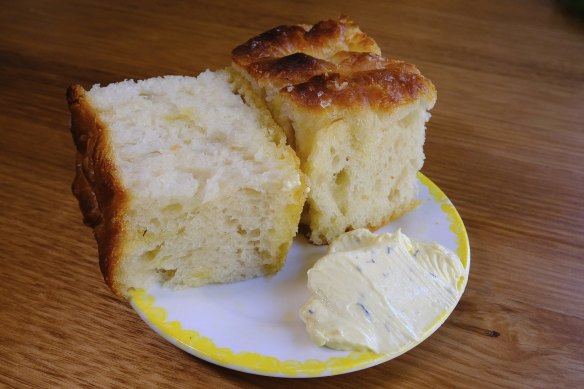
Focaccia
When you make dough every day, you start to understand it: what it needs and when it needs it, how much liquid it can absorb, and how far to take it in its first and second rise (leave it too long and you risk over-proving it, and the baked bread won’t be as fluffy and tall; don’t leave it long enough and the bread won’t reach its full potential). Making this daily at the restaurant means I have gotten to know this bread intimately. It has been tested at different temperatures, for different times, in the tin for the whole cook, and then out of the tin for the last few minutes to see if the crispy bottom you get without the tray is worth the effort of flipping. I think you can make it just as well in a home kitchen and I am excited for you to try. It is worth seeking out very good quality extra-virgin olive oil as it deeply penetrates the dough, lending flavour and texture to the bread.
INGREDIENTS
- 11g dried yeast
- 15g sugar
- 750ml (3 cups) lukewarm water
- 940g plain flour
- 43g fine sea salt
- 80ml (⅓ cup) extra-virgin olive oil, plus extra for greasing and drizzling
- butter for greasing
- 1 tbsp flaky salt
METHOD
To make the dough
- The dough will double in size, so you need to use an airtight container larger than you think, and it needs to have a matching lid. Put the yeast and sugar in the container.
- Slowly pour in the lukewarm water, and as you do so, whisk energetically to mix the sugar and yeast into the water. Let the mixture sit for 10 minutes to allow the yeast to activate. If the mixture doesn’t start bubbling, the yeast might be out of date or the water was too hot. If this is the case, start again with a fresh packet of yeast.
- When the yeast mixture is frothy, add the flour and then pour the salt over the top of the flour (be careful that the salt doesn’t directly touch the yeast, it could kill the yeast otherwise). Mix everything thoroughly with your hands for a few minutes until the dough is smooth with no lumps and it feels elastic.
- Next, pull a section of the dough away from the edge of the container to make a small well and pour in a quarter of the extra-virgin olive oil. Repeat this step three more times at equal distances around the edge of the dough until you have used all the oil.
- Now fold the oil into the dough. I like to use the following technique: starting at 12 o’clock, fold the outer edge of the dough into the centre of the container with your hands, then do the same at 3 o’clock, then 6 o’clock and finally 9 o’clock, folding the dough into the centre each time. Repeat this folding technique twice more, then turn the dough seam side down in the container. Seal with a tight-fitting lid and put it in the fridge to rest for 18–24 hours.
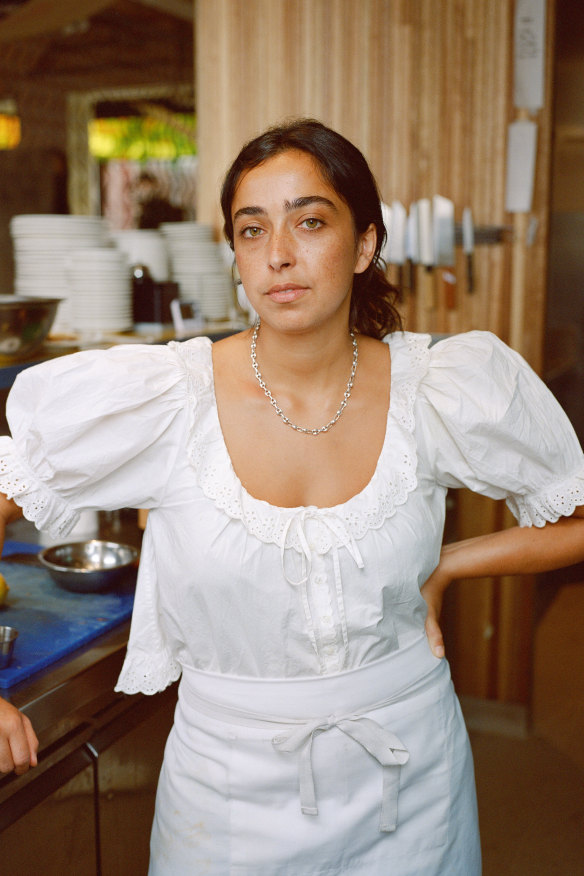
To bake the dough
- Butter a 30 cm × 25 cm stainless steel tin very well. Pour in 60ml (¼ cup) of oil – it might feel like too much, but it won’t be. Tip the tin so that the oil coats the sides as well as the bottom of the tin.
- Take the dough out of the fridge. Starting at 12 o’clock, fold the dough into the centre, and then do the same at 6 o’clock. Next, fold the dough into the centre at 3 o’clock, and then at 9 o’clock. Repeat this once more, then take the dough out of the container and put it into the tin seam side down. Gently stretch the dough out a little but don’t stretch it all the way to the edges, because the dough will expand to fill the tin as it proves. Find the warmest spot in your house and leave the dough to rise for 3-4 hours (but no longer than 4 hours), or until it has doubled in size. If your house isn’t warm, turn the heating on or the dough won’t rise.
- Preheat the oven to 220C fan-forced (240C conventional).
- Once risen, pour a drop of oil onto your hands and rub them together. Drizzle about 1 tablespoon of oil over the focaccia, then very gently rub the oil over the top, dimpling the surface by letting the tips of your fingers sink to the bottom of the tin. Small air bubbles should appear across the surface. Sprinkle with the flaky salt and give the focaccia one last drizzle with about 1 tablespoon of oil.
- Put in the oven and bake for 30 minutes, then increase the heat to 245C and bake for a further 10 minutes, until the bottom is very crispy and the top is darker than gold.
- Take the focaccia out of the oven and let it cool in the tin for 5 minutes, then turn it out and transfer to a cooling rack. Slice once the focaccia has cooled slightly, about 20 minutes.
Note: If the bottom is still a little soft when you turn the focaccia out of its tin, put the bread directly on the oven rack for another 5-10 minutes at 240C to crisp up on the bottom, with the empty tin beneath it to catch the oil drippings.
Makes 1 loaf
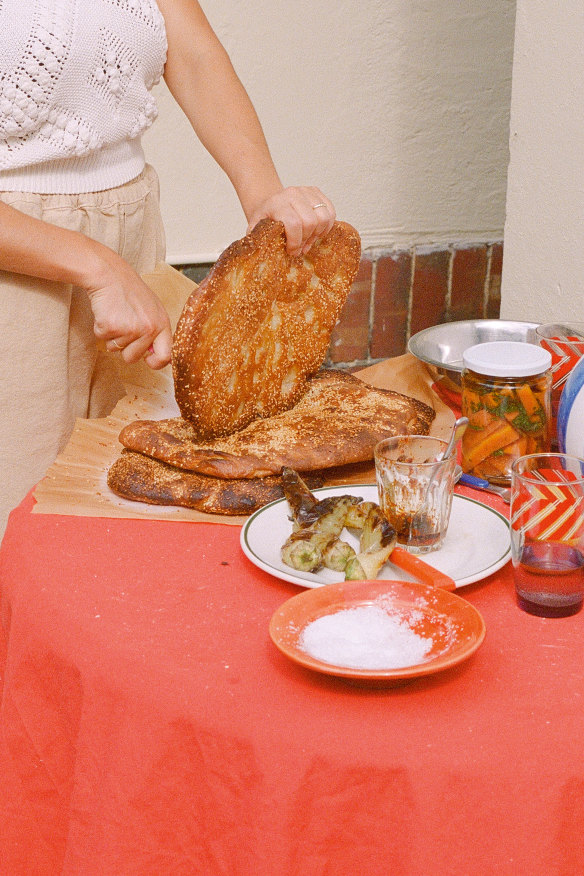
Sesame focaccia flatbread
This bread has the same foundation as the classic focaccia recipe, but without the focus on achieving a tall, fluffy rise. The loaf will be flatter than the focaccia, and taste of toasted, nutty sesame seeds. I bake mine until it is very dark and almost burnt. This flatbread looks great sliced into long pieces and placed in a pile for people to drag through matbukha or the sauce of chraime fish, or to layer with green chilli and tahini. Or you can make this flatbread-focaccia hybrid to accompany a summer kebab feast, along with a side of tomatoes covered in olive oil and zhoug.
INGREDIENTS
- 11g dried yeast
- 15g sugar
- 750ml (3 cups) lukewarm water
- 940g plain flour
- 43g fine sea salt
- 80ml (⅓ cup) extra-virgin olive oil, plus extra for greasing and drizzling
- butter for greasing
- 200g sesame seeds
METHOD
To make the dough
- Put the yeast and sugar in a container that can be sealed so it is airtight. The dough will double in size, so you need to use a large container.
- Slowly pour in the lukewarm water, and as you do so, whisk energetically to mix the sugar and yeast into the water. Let the mixture sit for 10 minutes to allow the yeast to activate. If the mixture doesn’t start bubbling, the yeast might be out of date or the water was too hot. If this is the case, start again with a fresh packet of yeast.
- When the yeast mixture is frothy, add the flour and salt. Mix everything thoroughly with your hands until the dough is smooth, with no lumps, and feels elastic.
- Next, pull a section of the dough away from the edge of the container to make a small well and pour in a quarter of the oil. Repeat this step three more times at equal distances around the edge of the dough until you have used all the oil.
- Now fold the oil into the dough using the following technique: starting at 12 o’clock, fold the outer edge of the dough into the centre of the container, then do the same at 3 o’clock, then 6 o’clock and finally 9 o’clock, folding the dough into the centre each time. Repeat this folding technique twice more, then turn the dough seam side down in the container. Seal with a tight-fitting lid and put it in the fridge to rest – you can leave it for up to two days but 18–24 hours is ideal.
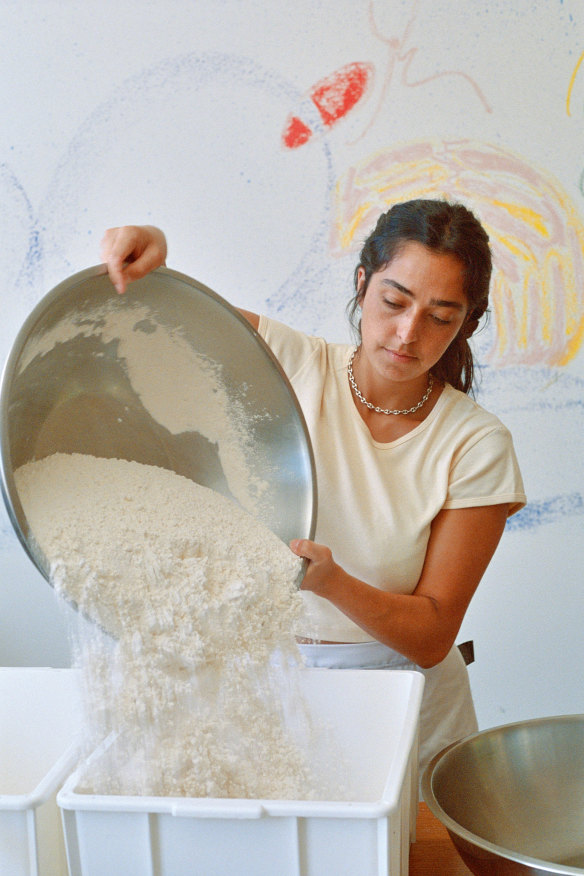
To bake the dough
- Grease two sheets of baking paper with butter and place them on a flat baking tray that is at least 30 cm long. Pour 20ml olive oil onto each sheet of baking paper.
- Divide the dough in half with your hands and put each half onto a tray.
- Use your palms to gently stretch each piece of dough out into a long, oval-shaped loaf about 2cm thick. Scatter half of the sesame seeds across the two loaves, then turn them over and do the same on the other side with the remaining seeds, making sure every inch is covered.
- Leave the loaves to rest for 1 hour at room temperature.
- Preheat the oven to 200C fan-forced (220C conventional).
- Before you put the loaves in the oven, stretch each loaf out again a little with your fingers, leaving a few dimples as you go.
- Put the trays in the oven for 15 minutes, then increase the temperature to 260C and bake for a further 15 minutes. The bread should look quite dark and the kitchen should smell of toasted sesame by now. If not, cook for a further 5-10 minutes.
- Take the loaves out of the oven and leave to cool for 5 minutes, then transfer to a rack. Slice once completely cool.
Makes 2 loaves

Whipped bottarga butter with fish roe
INGREDIENTS
- 200g good quality unsalted butter, diced and softened
- 40g bottarga (dried mullet or tuna roe), grated
- 1 tsp extra-virgin olive oil
- fish roe to serve (optional)
METHOD
- Whisk the butter for about a minute in an electric mixer fitted with the appropriate attachment until a little fluffy. Add the grated bottarga to the butter, along with the olive oil, and whisk again for a couple of minutes to evenly incorporate into the butter. If you feel like being a little extra decadent, serve the butter with a drop of fish roe on top.
Makes about 300g
Whipped sesame seed and schmaltz butter
INGREDIENTS
- 250g unsalted butter, diced and softened
- 7½ tbsp schmaltz oil (see below)
- 100g sesame seeds, toasted
- 2½ tsp flaky salt
- 75g crispy chicken skin
METHOD
- Whisk the butter in an electric mixer fitted with the appropriate attachment at a medium speed until it is soft and creamy. With the motor running, slowly pour the schmaltz oil into the butter, followed by the sesame seeds and salt, and whisk until combined. Next, add the chicken skin, breaking it up with your fingers as you go, and continue to whisk until incorporated. Taste and season with more salt to your liking. Using a spatula, spoon layer upon layer of the whipped butter onto a serving dish, aiming to create a mountainous shape. If it is too runny, put the butter in the fridge to firm up a little, then try again a few minutes later.
Makes about 70g
To make the schmaltz
INGREDIENTS
- 250g chicken skin (and fat too, if you can find it)
- 2 tbsp extra-virgin olive oil
METHOD
- Gently fry the chicken skin with 1 tablespoon of the extra-virgin olive oil in a heavy-based frying pan over a very low heat. Frying the chicken skin releases its fat, and as the fat slowly renders, the skin will crisp up until it is eventually crunchy. The rendered fat is called schmaltz.
- Once there is quite a bit of schmaltz pooling in the pan – this should take about 20 minutes – strain the oil into a bowl and set aside.
Serves 4 as a starter

This is an edited extract from Ellie’s Table by Ellie Bouhadana, published by Hardie Grant Books. Photography by Lucia Bell-Epstein.
Continue this series
Here are recipes from 30+ of the best cookbooks of 2024Up next
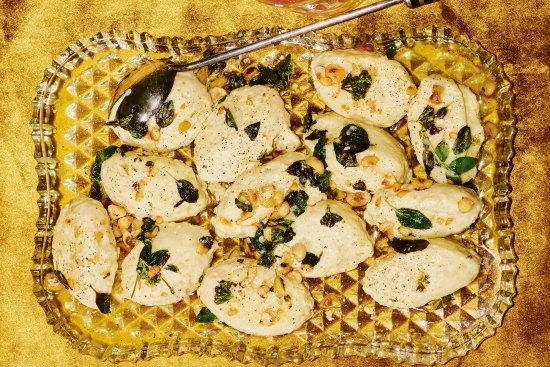
‘Gnocchi’s hotter sister’ plus more new vegan Italian recipes by chef Shannon Martinez
Serve these dishes to your nonna without saying they’re vegan and she won’t be able to tell the difference.
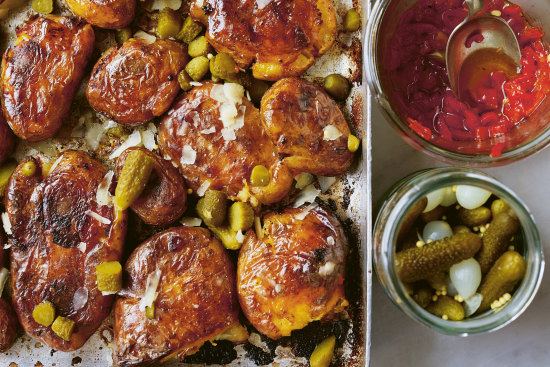
This pantry staple you usually throw out will make simple midweek spuds special
Squashed crisp-edged potatoes, tossed and baked in pickle brine to give them a subtle but important chip-shop feeling.
Previous

How to make Ho Jiak’s signature char kway teow (plus three other cult noodle dishes)
The Sydney restaurant’s popular rice noodle dish is spicy, smoky and much darker than the usual CKT. Founder Junda Khoo shares his secrets.
The best recipes from Australia's leading chefs straight to your inbox.
Sign up